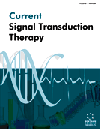- Home
- A-Z Publications
- Current Signal Transduction Therapy
- Previous Issues
- Volume 12, Issue 1, 2017
Current Signal Transduction Therapy - Volume 12, Issue 1, 2017
Volume 12, Issue 1, 2017
-
-
Remodelling of the Ca2+ Toolkit in Tumor Endothelium as a Crucial Responsible for the Resistance to Anticancer Therapies
More LessBackground: Invasive tumor growth and metastasis require the formation of a chaotic network of blood vessels that nourish cancer cells and provide them with a direct access to peripheral circulation, which is essential for them to diffuse throughout the organism. Tumor vascularization is sustained by multiple mechanisms, including sprouting angiogenesis and vasculogenesis, which consists in the recruitment of endothelial Read More
-
-
-
Toll-Like Receptor 4 Signaling Pathway as a Potential Targets for Stroke-Induced Inflammation
More LessAuthors: Jing Sun and Guangxian NanToll-like receptor 4 (TLR4) belongs to a large family of pattern recognition receptors that play a key role in innate immunity and inflammatory response. Increasing evidence has shown that TLR4 signaling pathway plays an essential role in mediating the immune response and central nervous system (CNS) repair and development. Brain inflammation and innate immunity has been implicated as a secondary injury mec Read More
-
-
-
Molecular Switch of AhR in Repression or Activation of Stem Cell Signaling
More LessAuthors: Yingqiu Xie, Xiuqing Zhang, Tomiris Atazhanova, Bindong Song and Qing YangBackground: Aryl hydrocarbon receptor (AhR) is an exogenous ligand-activating or constitutively active transcription factor. AhR regulates cellular differentiation, cell migration and other molecular and cellular processes. In general, AhR is biologically a very complex molecule in terms of its structure and functions in stemness, differentiation and clinical diseases. Here we review the debated issue of AhR in stem cell and canc Read More
-
-
-
A New Approach for Skin-Derived Precursors to Ameliorate Skin Photodamage Through Activation of Nrf2 Signaling Pathway
More LessAuthors: Dehai Xian, Jianqiao Zhong and Xiaoqing GaoBackground: Skin photodamage exhibits poorly clinical efficacy and so far has rarely satisfactory treatments. Ultraviolet (UV)-induced overproduction of reactive oxygen species (ROS), NF-E2-related factor 2 (Nrf2) inactivation and Nrf2/antioxidant response elements (ARE) signaling pathway blockage play important roles in skin photodamage pathogenesis. Skin-derived precursor cells (SKPs), a population of dermal st Read More
-
-
-
A Novel Approach for the Reduction of 50Hz Noise in Electrocardiogram Using Variational Mode Decomposition
More LessAuthors: Suchetha Manikandan and Kumaravel NatesanBackground: Electrocardiogram (ECG) signals provide confirmation about the cardiac rhythmic deviations and its function. But throughout the acquisition of Electrocardiogram signal from the human body, it becomes distorted with artifacts like 50 Hz power line interference, wandering of base line, respiratory signals and muscle artifacts. In spite of the noises in ECG, 50 Hz power line interference will relentlessly disturb the Read More
-
-
-
Pretreatment Serum Fibrinogen Levels are Associated with Postoperative Distant Metastasis and Prognosis of Resected Lung Cancer Patient: A Retrospective Study
More LessAuthors: Effat Un Nesa, Muhammad Shahbaz, Cong Wang, Han Zhang, Xiao Y. Liu, Ying Sun, Li Jingyi, Muhammad Ijaz, Tamanna Khanam, Peng X. Chen and Yufeng ChengObjective: Lung cancer is one of the main causes of cancer-related mortality. The identification of early diagnostic biomarkers improved outcomes for lung cancer patients. This study investigated the correlation of preoperative plasma fibrinogen level with distant metastasis and prognosis in lung cancer patients. Methods: A total of 139 lung cancer patients who underwent curative surgery between January 2009 and Novemb Read More
-
-
-
System Study of Vascular Smooth Muscle Cell (VSMC) Activation-Related Signaling Pathways by Monocyte and Macrophage Cells
More LessAuthors: Mohsen Khosravi, Seyed R. Hosseini-Fard and Mohammad NajafiBackground: The vessel stenosis and re-stenosis processes are mainly related to cellular and molecular events. The vascular smooth muscle cell (VSMC) activation is the basic element in these lesions. Based on monocyte and macrophage inflammatory responses and also VSMC motility, a complex protein network is dynamically proposed between these cells. The aim of this study was to highlight the protein communication Read More
-
Volumes & issues
-
Volume 20 (2025)
-
Volume 19 (2024)
-
Volume 18 (2023)
-
Volume 17 (2022)
-
Volume 16 (2021)
-
Volume 15 (2020)
-
Volume 14 (2019)
-
Volume 13 (2018)
-
Volume 12 (2017)
-
Volume 11 (2016)
-
Volume 10 (2015)
-
Volume 9 (2014)
-
Volume 8 (2013)
-
Volume 7 (2012)
-
Volume 6 (2011)
-
Volume 5 (2010)
-
Volume 4 (2009)
-
Volume 3 (2008)
-
Volume 2 (2007)
-
Volume 1 (2006)
Most Read This Month
Article
content/journals/cst
Journal
10
5
false
en


